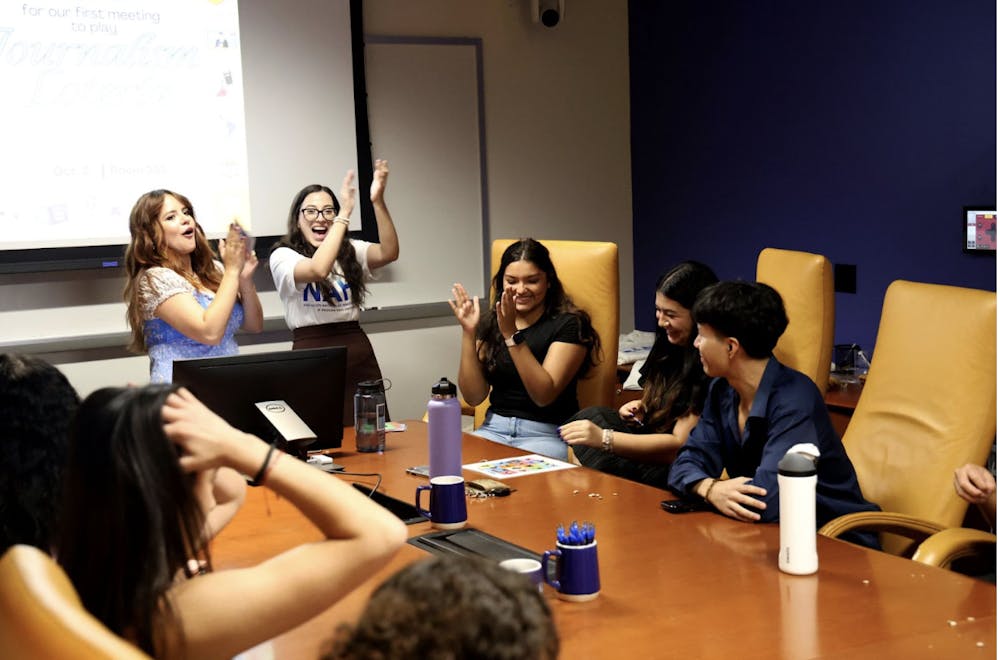PHOENIX– Arizona State University’s chapter of the National Association of Hispanic Journalists has helped make the school a home for Latino students studying journalism.
Arizona State University's (ASU) chapter of the National Association of Hispanic Journalists (NAHJ) is committed to advancing opportunities for Hispanics in the news industry, according to the club's description.
Members will network with and be mentored by professional Latino journalists and have opportunities to apply for scholarships, attend the national NAHJ conventions and meet fellow Hispanic classmates.
“For me, it was really important that I could find other Latino journalism students at the school and feel represented, heard and empowered,” Nicole Macias Garibay, ASU’s NAHJ President, said.
When Macias Garibay joined the club in spring of 2021 as a freshman, the club “died.” From 2022 to 2023, the club’s status as a student organization of ASU diminished as they did have a president or officers running NAHJ. Therefore, NAHJ was unable to register as an ASU student organization, taking away any funding the school also provides for student-run clubs.
However, she saw the downward spiral of NAHJ as an opportunity to revamp the club, rather than an ending to it. In 2023, she became the president of the club in order to get it back up and running.
“I just felt like there was a lot of potential for what it could be, so that's why I was like ‘oh, I want to be president,’” Macias Garibay said.
After moving to the United States by herself on an international student visa, Macias Garibay wanted to have a space to feel a part of a community.
“I wanted to feel like there was somebody in the classroom that could understand my cultural background and experiences,” she said.
Over her years studying at ASU’s journalism school, the Walter Cronkite School of Journalism and Mass Communication, Macias Garibay not only found a space for herself to feel at home, but also for many others.
Joana Cano, a freshman who attends the Cronkite school, said she knew about NAHJ before coming to school, but didn’t know ASU specifically held a chapter of it.
“I would describe it as a great opportunity, a great club to be in. If you're hispanic, it’s a great way to connect with other people and get a lot of opportunities,” Cano said.
Along with providing a relatable community for NAHJ students, the club also gives younger students a sense of mentorship with the upperclassmen. Just like how the program connects students with professional opportunities, it also offers students a network among each other.
“It’s a community hub for Hispanic journalists at Cronkite. We have a lot of shared experiences and it's a good environment to talk about those experiences, for older members to give advice on that and provide a safe space for the specific challenges and obstacles that we have to overcome in the industry,” Natalia Marrin, vice president of ASU’s NAHJ, said.
Marrin, a current sophomore at Cronkite, said she feels “very close to every single member” because of those shared experiences. Marrin has discovered that NAHJ’s community is a great way to “build understanding with younger members and older members.”
In addition to the community-building club meetings, the NAHJ is “trying to focus more on professional engagement programs,” which would help members to reach their professional goals, Marrin said. Examples of this include providing students with resources for internships and visits from Latino media professionals to share their stories with NAHJ members, Marrin said.
For Cano, events like those have helped her be able to try different branches of journalism and discover what she likes. She attended a Cronkite Noticias, an immersive professional program at the Cronkite school for bilingual journalists, workshop through NAHJ where she was able to try reporting, producing and anchoring in the Cronkite school’s newsroom.
“I feel like we don't get as many opportunities as a freshman,” Cano said, “But I loved anchoring, it's something I want to do.”
Growing up, Macias Garibay lived in many border cities, including Juárez. She would walk from Juárez across the border to go to school in El Paso, Texas.
Macias Garibay then attended a community college where she would live in Mexico, but go to that college in the U.S. “because there was a facility that could do that,” she said, this is a system that is “very common” at the border.
“I was really happy that I was able to attend ASU, the Cronkite school, because I was awarded a scholarship by the Arizona Mexico Commission,” Macias Garibay said.
Before the fall semester comes to a close, NAHJ is holding a “professional headshots workshop,” Marrin said. Macias Garibay said the club will celebrate Las Posadas together, which includes a potluck and secret santa.
“It’s nice to hang out with people from NAHJ outside of school,” Macias Garibay said, “These people are my friends, and so that feels really nice.”

